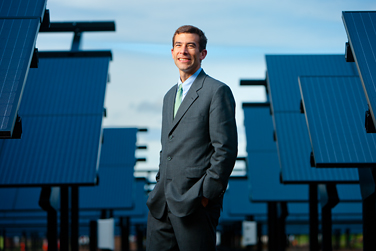News
‘Green’ efforts needed different thinking

Ryan McPherson, UB’s chief sustainability officer, says the Solar Strand will spur solar-technology development statewide. Photo: DOUGLAS LEVERE
Five years ago, UB pledged to reduce or offset its greenhouse gas emissions by 2030.
How will the university accomplish that?
Ryan McPherson, the university’s chief sustainability officer, explained to an audience at the North Campus Newman Center last night that UB will not only continue to invest in renewable energy and construct eco-friendly buildings, but it also will rely on more modest approaches, such as composting, bicycle sharing and using energy-efficient light bulbs.
“To achieve that,” McPherson said, “we had to start thinking very differently.”
He was speaking to about 60 people at the latest installment of The Bridge Lecture Series, a weekly summer gathering hosted by the Newman Center. Previous speakers included UB head football coach Jeff Quinn and Alan Rabideau, professor of civil, structural and environmental engineering.
McPherson detailed UB’s long history of environmental leadership, which dates back to the 1970s as the crisis at Love Canal unfolded. UB researchers played a role investigating the toxic chemicals buried underneath the Niagara Falls neighborhood, he said.
The university started doing energy audits of its buildings during the 1980s, a precursor to the energy-efficiency push that has swept across the United States in recent years due to soaring energy prices, he said.
In 2007, UB took matters even further by signing the American College and University Presidents’ Climate Commitment. It was one of 150 institutions of higher learning to agree to reduce or offset their greenhouse gas emissions. More than 500 colleges and universities have since signed the pact.
UB has embraced green building principles to reach the goal, McPherson said. For example, the William R. Greiner Residence Hall recently was certified gold under the U.S. Green Building Council’s Leadership in Energy and Environmental Design (LEED) rating system. It one of six buildings recently built or planned at the university to earn LEED certification.
McPherson noted that the U.S. Environmental Protection Agency in April ranked UB as the 14th-largest green power user among the nation’s colleges and universities. The ranking could improve because UB flipped the switch on its Solar Strand, a 750-kilowatt solar installation, shortly after the EPA released its findings.
The strand’s $7 million price tag, funded by the New York Power Authority, drew a few comments from audience members concerned about the economics of the project. Despite a projected savings of at least $60,000 per year in electricity costs, the strand will take decades to pay for itself, McPherson said.
Nonetheless, it’s a demonstration project that will spur solar-technology development statewide, potentially reducing the costs of similar projects and serving as an outdoor classroom for UB students and the public, he said.
“The strand has really been a fantastic project,” he said. “We believe this will be the most publicly accessible renewable energy park not just in the country, but the world.”
The university also is recycling materials, such as brick pavers and student mattresses, and reupholstering aging furniture. The idea, McPherson said, is not only to save money and energy resources, but to educate and inspire people both on and off campus to live a more sustainable lifestyle.
For more information about sustainability research and initiatives at UB, visit the UB Green website.

Reader Comments